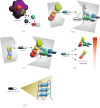Understanding, diagnosing, and treating pancreatic cancer from the perspective of telomeres and telomerase
- PMID: 38594465
- PMCID: PMC11405285
- DOI: 10.1038/s41417-024-00768-6
Understanding, diagnosing, and treating pancreatic cancer from the perspective of telomeres and telomerase
Abstract
Telomerase is associated with cellular aging, and its presence limits cellular lifespan. Telomerase by preventing telomere shortening can extend the number of cell divisions for cancer cells. In adult pancreatic cells, telomeres gradually shorten, while in precancerous lesions of cancer, telomeres in cells are usually significantly shortened. At this time, telomerase is still in an inactive state, and it is not until before and after the onset of cancer that telomerase is reactivated, causing cancer cells to proliferate. Methylation of the telomerase reverse transcriptase (TERT) promoter and regulation of telomerase by lactate dehydrogenase B (LDHB) is the mechanism of telomerase reactivation in pancreatic cancer. Understanding the role of telomeres and telomerase in pancreatic cancer will help to diagnose and initiate targeted therapy as early as possible. This article reviews the role of telomeres and telomerase as biomarkers in the development of pancreatic cancer and the progress of research on telomeres and telomerase as targets for therapeutic intervention.
© 2024. The Author(s).
Conflict of interest statement
The authors declare no competing interests.
Figures





Similar articles
-
The role of telomeres and telomerase in cirrhosis and liver cancer.Nat Rev Gastroenterol Hepatol. 2019 Sep;16(9):544-558. doi: 10.1038/s41575-019-0165-3. Epub 2019 Jun 28. Nat Rev Gastroenterol Hepatol. 2019. PMID: 31253940 Review.
-
Telomerase reactivation is associated with hepatobiliary and pancreatic cancers.Hepatobiliary Pancreat Dis Int. 2020 Oct;19(5):420-428. doi: 10.1016/j.hbpd.2020.04.007. Epub 2020 May 1. Hepatobiliary Pancreat Dis Int. 2020. PMID: 32386990 Review.
-
Telomerase inhibitor Imetelstat (GRN163L) limits the lifespan of human pancreatic cancer cells.PLoS One. 2014 Jan 7;9(1):e85155. doi: 10.1371/journal.pone.0085155. eCollection 2014. PLoS One. 2014. PMID: 24409321 Free PMC article.
-
Regulation and Effect of Telomerase and Telomeric Length in Stem Cells.Curr Stem Cell Res Ther. 2021;16(7):809-823. doi: 10.2174/1574888X15666200422104423. Curr Stem Cell Res Ther. 2021. PMID: 32321410 Review.
-
Role of Telomeres and Telomerase in Aging and Cancer.Cancer Discov. 2016 Jun;6(6):584-93. doi: 10.1158/2159-8290.CD-16-0062. Epub 2016 Mar 30. Cancer Discov. 2016. PMID: 27029895 Free PMC article. Review.
Cited by
-
A Practical Format to Organize Cancer Constellations Using Innate Immune System Biomarkers: Implications for Early Diagnosis and Prognostication.Int J Transl Med (Basel). 2024 Dec 6;4(4):726-739. doi: 10.3390/ijtm4040050. Int J Transl Med (Basel). 2024. PMID: 40129890 Free PMC article.
References
Publication types
MeSH terms
Substances
LinkOut - more resources
Full Text Sources
Medical
Miscellaneous

